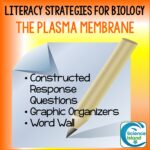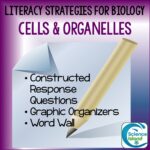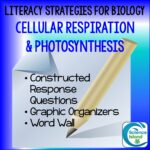
Menu
Many science teachers feel overwhelmed by literacy initiatives. While we may know our biology backward and forwards, we don’t always feel adequately prepared to teach students how to read and write. Over the years, various initiatives have been introduced. I remember “Writing Across the Curriculum” and “Reading in the Content Area” from years ago. We all understand that it’s not just what students know, but how well they can communicate what they know.
So, the question is “How do you teach your Biology curriculum AND facilitate improved reading and writing at the same time?”
Chances are pretty good that you already do a lot of things in your average teaching day that incorporate reading and writing. There are many literacy strategies that can be used by science teachers, but it’s important that you deliberately and thoughtfully use them on a regular basis. The problem, of course, is time. For example, if you want to implement constructed response questions you have to find time to design standards-based questions, develop scoring rubrics, and then read and score each response. And, how many students do you have? 130? 140?
I have just released a new product series “Literacy Strategies for Biology” that will make your efforts to meet literacy objectives in your Biology classroom a little easier. For this product, I chose three research-based instructional methods that have worked well for my students in recent years: constructed responses, graphic organizers, and word walls. The focus of this post, and the most difficult literacy strategy for most content-area teachers to implement, is constructed response questions.
Literacy Strategies for Biology includes three products: “Plasma Membrane”, “Cells and Organelles”, and “Cellular Respiration and Photosynthesis”.
Each product includes five Constructed Response Questions aligned to NGSS High School Life Science Standards and CCSS in Reading and Writing for grades 9 & 10 with a Teacher’s Guide and 3-point Scoring Rubric for each question.



A well-written item will ask students to apply knowledge, skills, and critical thinking to answer a standards-driven question or performance task. Students will move beyond basic knowledge and comprehension as they analyze a situation and think more deeply about content. They will need to organize their thoughts through writing as they summarize, synthesize and reflect on what they’ve read in science texts or discovered through lab investigations.
If you’re new at implementing literacy strategies, try scaffolding your instruction using the “I DO – WE DO – YOU DO” method. So, the first time you present a constructed response item to your class, do it while “thinking out loud” in front of your students. Let them see how you break the question down into parts and interpret what is being asked. Then, show them how you construct a written answer to the question or questions and how your answer would be scored using the rubric. This is the “I DO”. Next time, try the “WE DO” by working together as a class or organizing students into small groups to construct a response. Then, let them use the rubric to assess their response. Eventually, you can work up to the “I DO” where students understand what is expected in a constructed response and are comfortable with self-assessment and peer assessment using the rubric. Be patient with this process and it will pay off!
In my “Literacy Strategies for Biology” products, the Teacher’s Guide and Scoring Rubric are set up so that you can see the parts of a question at a glance. Correct answers are given along with additional details that may be offered by students for additional credit (if you so choose) or as points for further discussion. Three-point rubrics are laid out in an easy-to-follow format so the student or a peer can efficiently score papers when you read through the rubric as students assign points for correct responses. Click on any of the images above to see more detailed previews of these resources.
If you teach in an academy or on a team, these strategies can complement your interdisciplinary efforts when students share their responses in Language Arts class for assessment of sentence structure, grammar, and spelling.
What Literacy Strategies have worked well in your secondary science classroom?
Happy Teaching!
Aloha,
Carla

Sign Up for the Science Island Newsletter and Free Resource Library.
Then check your email to confirm your subscription.